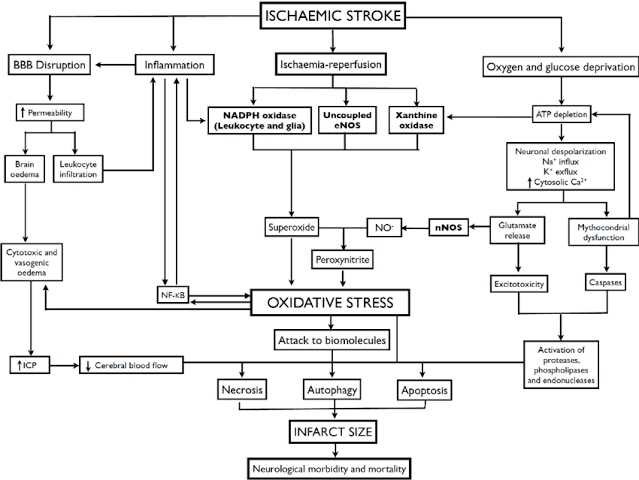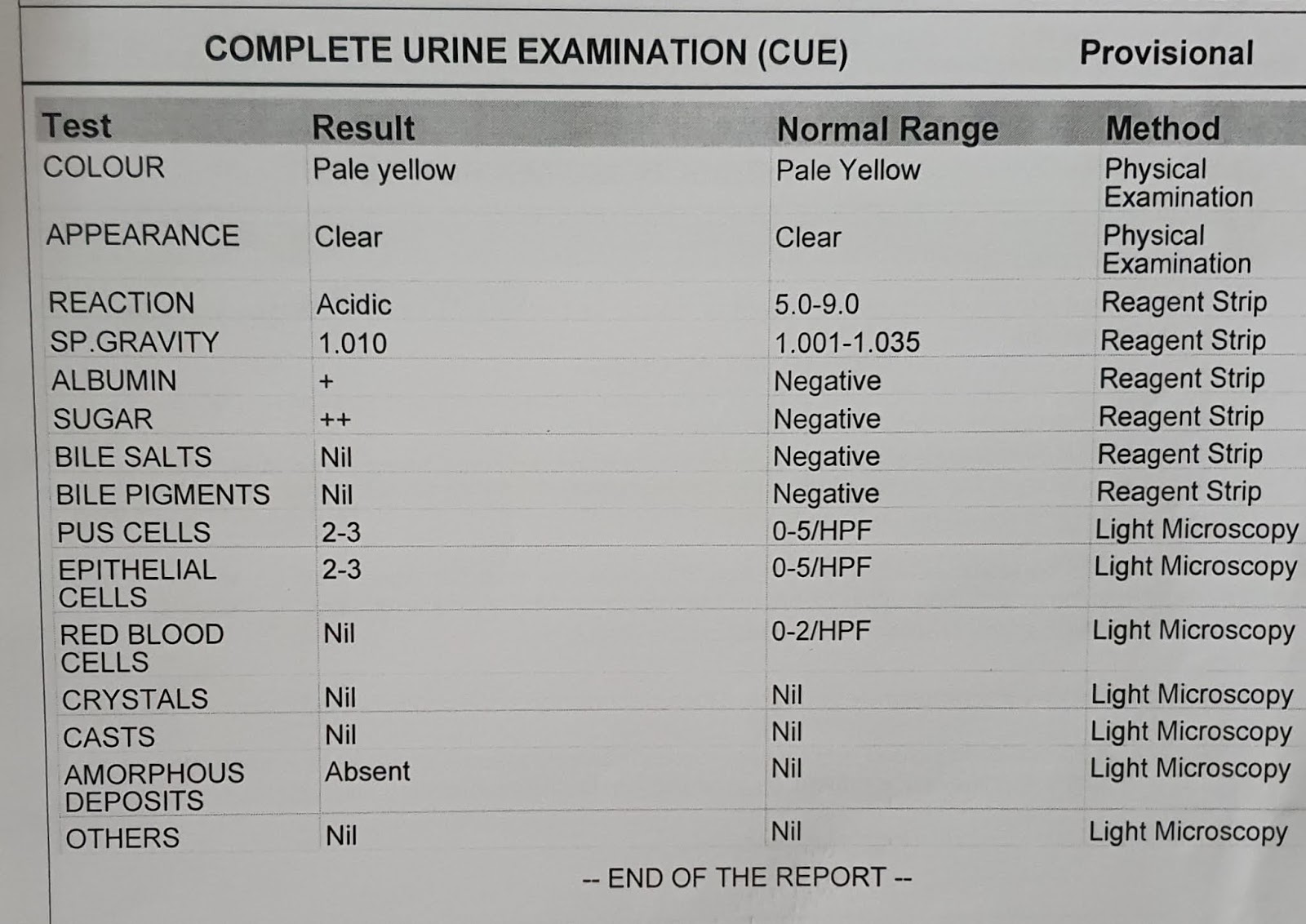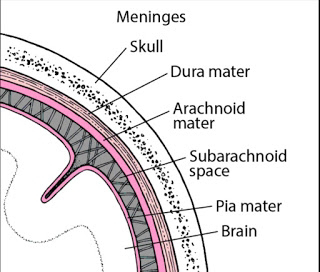monthly internal assessment
1) A 55 year old man with Recurrent Focal Seizures
Detailed patient case report here: http://ushaindurthi.blogspot.com/2020/11/55-year-old-male-with-complaints-of.html
1. What is the problem representation of this patient and what could be the anatomical site of lesion ?
A 55 year old male construction worker with Type 2 Diabetes mellitus who is a chronic alcoholic & smoker came with c/o weakness of right upper limb with involuntary movements of both right UL & LL
The anatomical site of lesion may be internal capsule(left sided) as it is the most common site for lacunar infarcts,also presents as hemiparesis.
2. Why are subcortical internal capsular infarcts more common that cortical infarcts?
subcortical infarcts are caused by occlusion of a penetrating artery from a large cerebral artery, most commonly from the Circle of Willis. These penetrating arteries arise at sharp angles from major vessels and are thus, anatomically prone to constriction and occlusion. So subcortical infarcts are more common than cortical infarcts.
3. What is the pathogenesis involved in cerebral infarct related seizures?
4. What is your take on the ecg? And do you agree with the treating team on starting the patient on Enoxaparin?
Left axis deviation +
ST depressions noted in precordial leads V1 to V6
so NSTEMI
Yes , i agree with the treating team on starting the patient on Enoxaparin.
https://www.sciencedirect.com/science/article/pii/S0735109702029017
5. Which AED would you prefer?If so why?Please provide studies on efficacies of each of the treatment given to this patient.
As it is focal seizure i would prefer carbamazepine And lorazepam / diazepam to prevent the conversion of focal seizure to GTCS
Antiepileptics https://pubmed.ncbi.nlm.nih.gov/28661008/
Atorvastatin https://www.ncbi.nlm.nih.gov/pmc/articles/PMC6036014/
Aspirin https://www.ncbi.nlm.nih.gov/pmc/articles/PMC6206448/
Enoxaparin https://www.sciencedirect.com/science/article/pii/S0735109702029017
case 2http://manojkumar1008.blogspot.com/2020/12/shortness-of-breath-with-high-sugars.html
Questions:
1. What is the problem representation for this patient?
A 55 year old male with
1) Hypoglycemia : giddiness and profuse sweating with GRBS -34mg/dl
2) Shortness of breath (grade 2-3) since 3 days
3) Dry Cough since 3 days
4)K/C/O DM II and HTN since 10 years.
2. What is the cause for his recurrent hypoglycemia? And how would you evaluate?
Drug induced Hypoglycemia as patient is on OHA.Elevated Serum Creatinine and Significant loss of proteins in his urine indicates Renal Failure.

3.What is the cause for his Dyspnea? What is the reason for his albumin loss?
Patient being morbidly obese might have lead to dyspnea because of decreased cheat wall complaiance.Due to diabetic nephropathy,where there is albuminuria might have lead to Hypoalbuminemia.
4. What is the pathogenesis involved in hypoglycemia ?
3(A)41 year old man with Polyarthralgia
Case details here: https://mahathireddybandari.blogspot.com/2020/11/41m-with-chest-pain-and-joint-pains.html?m=1
1. How would you evaluate further this patient with Polyarthralgia?
2. What is the pathogenesis involved in RA?
3. What are the treatment regimens for a patient with RA and their efficacies?
:https://www.ncbi.nlm.nih.gov/pmc/articles/PMC6348345/
3(B)75 year old woman with post operative hepatitis following blood transfusion
Case details here: https://bandaru17jyothsna.blogspot.com/2020/11/this-is-online-e-log-book-to-discuss.html
1.What are your differentials for this patient and how would you evaluate?
-Post transfusion delayed hemolytic reaction
Evaluation:
-ABO and Rh compatability
-Transfusion related acute hepatic injury (TRAHI)
-Post transfusion hepatitis
-Ischemic hepatitis
Evaluation:
2. What would be your treatment approach? Do you agree with the treatment provided by the treating team and why? What are their efficacies?
Symptomatic management
I agree with the treatment provided by the treating team
Lasix & Nebulization : For wheezing and crepts
Lactulose : To prevent hepatic encephalopathy
Zofer : For vomitings
Pantop : To prevent gastritis
http://manojkumar1008.
1. What is the problem representation of this patient?
A 60 year old female with T2DM & HTN since 2 years c/o pricking type of chest pain since 4 days and uncontrolled sugars secondary to ? right upper lobe pneumonic consolidation with sepsis
2. What are the factors contributing to her uncontrolled blood sugars?
Hyperdense area noted in the right upper lobe
4. What do you think is the cause for her hypoalbuminaemia? How would you approach it?
- Inflammation (acute phase reactant)
- Malnutrition
- Albuminuria (protein losing nephropathy)
- Piptaz & clarithromycin : for his right upper lobe pneumonic consolidation and sepsis
- Egg white & protien powder : for hypoalbuminemia
- Lactulose : for constipation
- Actrapid / Mixtard : for hyperglycemia
- Tramadol : for pain management
- Pantop : to prevent gastritis
- Zofer : to prevent vomitings
5) 56 year old man with Decompensated liver disease
Case report here: https://appalaaishwaryareddy.blogspot.com/2020/11/56year-old-male-with-decompensated.html
1. What is the anatomical and pathological localization of the problem?
Liver : Chronic liver disease (cirrhosis) secondary to HBV
Kidney : AKI on CKD (Hepatorenal syndrome) , Hyperkalemia
GI : GAVE , portal hypertensive gastropathy
Lung : pneumonia , pleural effusion
2. How do you approach and evaluate this patient with Hepatitis B?
3) What is the pathogenesis of the illness due to Hepatitis B?
4. Is it necessary to have a separate haemodialysis set up for hepatits B patients and why?
Yes , separate machines must be used for patients known to be infected with HBV (or at high risk of new HBV infection). A machine that has been used for patients infected with HBV can be used again for non-infected patients only after it has been decontaminated HBV because of increased risk of transmission due to contamination
5. What are the efficacies of each treatment given to this patient? Describe the efficacies with supportive RCT evidence.
Lactulose : for prevention and treatment of hepatic encephalopathy.
Tenofovir : for HBV
Octreotide : for upper GI bleed. https://www.ncbi.nlm.nih.gov/pmc/articles/PMC1750992/#:~:text=In%20a%20meta-analysis%2C%20somatostatin,(mostly%20caused%20by%20gastritis).
Lasix : for fluid overload (AKI on CKD) https://www.ncbi.nlm.nih.gov/books/NBK499921/#:~:text=The%20Food%20and%20Drug%20Administration,failure%20including%20the%20nephrotic%20syndrome.
Vitamin -k : for ? Deranged coagulation profile (PT , INR & APTT reports not available)
Pantop : for gastritis
Zofer : to prevent vomitings
Monocef (ceftriaxone) : for AKI (? renal)
Case report details: http://
1. What is the problem representation of this patient?
A 58 year old weaver occasional alcoholic c/o slurring of speech , deviation of mouth to right side associated with drooling of saliva , food particles and water predominantly from left angle of mouth and smacking of lips since 6 months.
2. How would you evaluate further this patient with Dementia?
4. What is the likely pathogenesis of this patient's dementia?
(1) Neurotoxicity, including dysregulated glutamate and calcium signaling, and neurotransmission imbalance contribute to synaptic dysfunction and neuronal loss
(2) Glia activation, including microglia and astrocytes, interfere with immunological processes in the brain further promoting non-resolving inflammation and neurodegeneration
(3) Tau phosphorylation and neurofibrillary tangle formation;
(4) Aβ plaque formation are key hallmarks of the AD brain. Specialized pro-resolving mediators and strategies aimed at boosting resolution such as using omega-3 polyunsaturated fatty acid exert differential effects on these targets and provide anti-inflammatory and pro-cognitive effects in neuroinflammation/degeneration
(5) The accumulation of Aβ may lead to the microglial accumulation and activation resulting in increases in pro-inflammatory cytokines such as interleukin-1 beta, interleukin-6, and tumor necrosis factor-alpha. These cytokine increases in the brain can subsequently lead to tau hyperphosphorylation and a pathological cycle of increased Aβ deposition and persistent microglial activation, ultimately resulting in chronic neuroinflammation and neurodegeneration.
5. Are you aware of pharmacological and non pharmacological interventions to treat such a patient and what are their known efficacies based on RCT evidence?
- Donepezil
- Rivastigmine
- Galantamine
- Memantine
- Counselling the patient and care givers
- Geriatric care
- Cognitive / emotion oriented interventions
- Sensory stimulation interventions
- Behaviour management techniques
7) 22 year old man with seizures
Case report here http://geethagugloth.blogspot.com/2020/12/a-22-year-old-with-seizures.html
1. What is the problem representation of this patient ? What is the anatomic and pathologic localization in view of the clinical and radiological findings?
A 22 year old delivery boy chronic alcoholic and tobacco chewer c/o on & off fever since 1 year , involuntary weight loss since 6 months , headache since 2 months , 4 - 5 episodes of involuntary stiffening of both UL & LL with 5 min LOC 1 week before the day of admission.
Brain - multiple ring enhancing lesions in right cerebellum ? Tuberculoma
2. What the your differentials to his ring enhancing lesions?
Bacterial
Pyogenic abscess
Tuberculoma and tuberculous abscess Mycobacterium avium-intracellulare infection Syphilis
Listeriosis
Fungal
Nocardiosis
Actinoimycosis
Histoplasmosis
Coccidioidomycosis
Aspergillosis
Mucormycosis
Paracoccidioidomycosis
Cryptococcosis
Parasitic
Neurocysticercosis
Toxoplasmosis
Amoebic brain abscess
Echinococcosis
Chagas' disease
Neoplastic
Metastases
Primary brain tumor
Primary CNS lymphoma
Inflammatory and demyelinating
Multiple sclerosis
Acute disseminated encephalomyelitis
Sarcoidosis
Whipple's disease
Systemic lupus erythematosus
3. What is "immune reconstitution inflammatory syndrome IRIS and how was this patient's treatment modified to avoid the possibility of his developing it?
A paradoxical clinical worsening of a known condition or the appearance of a new condition after initiating anti retroviral therapy (ART) therapy in HIV-infected patients resulting from restored immunity to specific infectious or non-infectious antigens is defined as immune reconstitution inflammatory syndrome (IRIS).
As his CD4 count is > 50 /mm3 consider delayed initiation of ART ideally after 8 weeks of starting ATT to reduce the chances of developing IRIS
8) Please mention your individual learning experiences from this month.
Ascitic Tap
Transfusion reaction
Hypertensive urgency management
Status epilepticus management


























